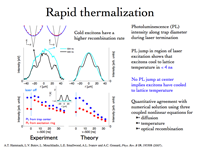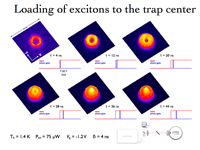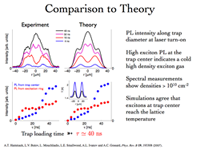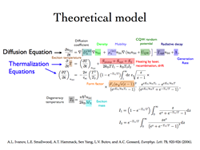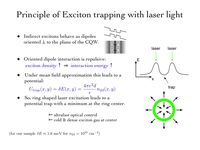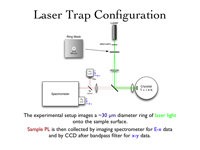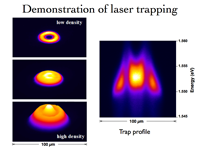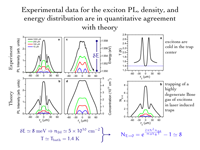Kinetics of excitons in the optically-induced trap |
|
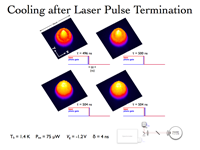
|
Measurements of the kinetics of excitons in in the optically-induced trap show that excitons in the region of laser excitation cool rapidly—within 4 ns—to the lattice temperature T = 1.4 K, while the excitons at the trap center are found to be cold—essentially at the lattice temperature—even during the excitation pulse. The transport time of excitons to the trap center is about 40 ns, longer than the cooling time yet shorter than the lifetime of the indirect excitons. The observed time hierarchy τcooling < τtransport < τlifetime is favorable for creating a dense and cold exciton gas in optically-induced traps and for in situ control of the gas by varying the excitation profile in space and time before the excitons recombine. A.T. Hammack, L.V. Butov, L. Mouchliadis, A.L. Ivanov, and A.C. Gossard, Kinetics of indirect excitons in an optically-induced trap in GaAs quantum wells, arXiv:0706.4194v1 (2007); Phys. Rev. B 76, 193308 (2007). |
Optically-induced trapping of excitons |
|
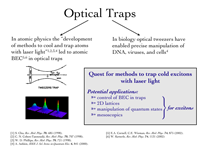
|
Indirect excitons, formed from electrons and holes that are confined to different QWs by a potential barrier, behave as dipoles oriented perpendicular to the plane, and an increasing exciton density causes an increase of the interaction energy. The repulsive character of the interaction is evidenced in experiments as a positive and monotonic line shift with increasing density, δE(x,y) = 4π e2n2D d/ε. Due to the repulsive interaction, a ring-shaped laser spot should form a potential trap with the energy minimum at the ring center. Similarly to all optical traps, an important advantage of the laser induced exciton trapping is the possibility of controlling the trap in-situ by varying the laser intensity in space and time. Moreover, the excitons at the trap center are cold since they are far from the hot laser excitation ring. The long lifetimes of the indirect excitons allow them to travel to the trap center, due to their drift and diffusion, before optical recombination. This leads to accumulation of a cold and dense exciton gas at the trap center. A.T. Hammack, M. Griswold, L.V. Butov, L.E. Smallwood, A.L. Ivanov, and A.C. Gossard, Trapping of Cold Excitons in Quantum Well Structures with Laser Light, cond-mat/0603597 (2006); Phys. Rev. Lett. 96, 227402 (2006). |


